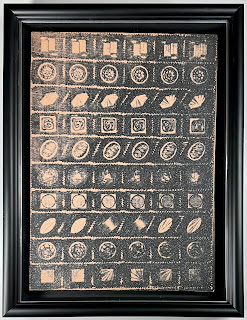Diamond Dust Candy Box, 1981; Synthetic polymer paint, diamond dust, and silkscreen ink on canvas; Stamped with the Estate of Andy Warhol and the Andy Warhol Foundation for the Visual Arts stamps; Numbered VF PA13.005 on the overlap; Numbered twice 'PA13.005' on the stretcher; Size - Canvas: 14 x 10", Frame 17 x 13 1/4"; Framed using a black wood frame and plexiglass.
"You take some chocolate... and you take two pieces of bread... and you put the candy in the middle and you make a sandwich of it. And that would be cake." - Andy Warhol
Andy Warhol loved chocolate and many days, at lunchtime, he would go the Upper East side restaurant "Serendipity" for it's speciality; a glass of frozen hot chocolate. He also had an insatiable sweet tooth, he said "When I was a child I never had a fantasy about having a maid, what I had a fantasy about having was candy. As I matured that fantasy translated itself into 'make money to have candy,' because as you get older, of course, you get more realistic." In the 1980's Warhol would seize on his love of chocolate candy to create a series of paintings and prints that had as their subject matter open and closed chocolate boxes.
Close up of the Estate of Andy Warhol and the Andy Warhol Foundation for the Visual Arts stamps; and the unique authentication number VF PA13.005 on the overlap.
Close up of the unique authentication number VF PA13.005 inscribed twice on the stretcher.
Andy Warhol's paintings of candy boxes was a refreshing return to his 1960's consumerism as well as nod to his love of chocolate. The artworks that were created were used as holiday and personal gifts to friends and associates. Some of the paintings show a beautifully wrapped heart shaped chocolate box (invented by the English chocolatier Richard Cadbury), while this example showcases the chocolate candy contained within a rectangular box. Unlike the paintings of just the boxes, some of the paintings of the chocolates themselves are also diamond dusted. The glittering diamond dust adds to the delectable, delicious, and decadent appeal of the chocolate bon bons.
Warhol's use of diamond dust is owed to his friend John Reinhold; who was a diamond dealer and art collector. One day John gave Warhol a jar of diamond dust, suggesting he could incorporate it into his artwork; which lead to the Diamond Dust series for both prints and paintings. John Reinhold's wife Susan co-founded the Reinhold-Brown Gallery, and Warhol painted portraits of John Reinhold and his and Susan's ten year old daughter Berkeley. In 1981 Warhol gave Berkeley an 80 page leather-bound diary. On each page was drawn abstract forms that slowly progress and develop page-by-page into a beautiful dollar sign. In 2010 Rizzoli published a reproduction of the diary in book form entitled "Andy Warhol: Making Money.
"Diamond Dusted Chocolate Box" is an exceptional example of Pop Artist Andy Warhol as his best. The image of an open box of glittering chocolate candies is instantly recognized and immediately causes the viewer's mouth to water. The inconsistent screen printing of the chocolates likens back to Warhol's rough screening of the Campbell's Soup Cans and Marylin Monroe paintings of the 1960's. This is an absolutely fantastic unique work on canvas by the great Pop artist Andy Warhol and would be a standout of any art collection!
Warhol's use of diamond dust is owed to his friend John Reinhold; who was a diamond dealer and art collector. One day John gave Warhol a jar of diamond dust, suggesting he could incorporate it into his artwork; which lead to the Diamond Dust series for both prints and paintings. John Reinhold's wife Susan co-founded the Reinhold-Brown Gallery, and Warhol painted portraits of John Reinhold and his and Susan's ten year old daughter Berkeley. In 1981 Warhol gave Berkeley an 80 page leather-bound diary. On each page was drawn abstract forms that slowly progress and develop page-by-page into a beautiful dollar sign. In 2010 Rizzoli published a reproduction of the diary in book form entitled "Andy Warhol: Making Money.
Framed "Diamond Dust Candy Box," 1981 by Andy Warhol
"Diamond Dusted Chocolate Box" is an exceptional example of Pop Artist Andy Warhol as his best. The image of an open box of glittering chocolate candies is instantly recognized and immediately causes the viewer's mouth to water. The inconsistent screen printing of the chocolates likens back to Warhol's rough screening of the Campbell's Soup Cans and Marylin Monroe paintings of the 1960's. This is an absolutely fantastic unique work on canvas by the great Pop artist Andy Warhol and would be a standout of any art collection!
Video of the surface of "Diamond Dust Candy Box" 1981 by Andy Warhol





No comments:
Post a Comment